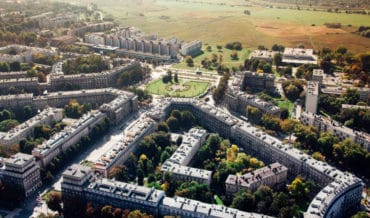In 1880, prince Aleksander Lubomirski, who lived in Paris, donated two million francs for the construction and maintenance of “a shelter for abandoned or bad boys”. Outside the city, at today’s no 27 Rakowicka Street in Krakow, a complex of buildings was erected thanks to the excellent designs of Tadeusz Stryjeński and Władysław Ekelski, in 1888-1893 a complex of buildings distinguished not only by excellent utility but also by high artistic values was created. In the shelter there was a 4-class folk school, various workshops, a gymnasium, a swimming pool and living rooms for 150 boys from 8 to 18 years old. From 1911, the Salesians took over the running of the plant. During World War I, the facility was converted into a hospital for infectious diseases, and immediately after the war into a military hospital. The shelter began to function again only in 1925, unfortunately Lubomirski’s iron fund was significantly reduced due to inflation, so the shelter functioned out of the benevolence of the society and their voluntary contributions. During World War II, the shelter was used by the Germans for military purposes, after the liberation it was a repatriation camp for soldiers, and then a hospital of the Soviet army. In 1946-1950 the shelter was reactivated and then passed into the hands of the University of Economics. In 1888 Lubomirski donated another million francs to the second foundation of his name. According to Zaremba’s plans, it was built in Łagiewniki in Podgórze. It was a girls’ shelter
Suggested
Suggested contents and articles.
Suggested Contents
The Podgórski Bridge is a non-existent bridge built in the years 1844-1850 at the end of today’s Mostowa and K. Brodzińskiego Streets in Krakow. The bridge was designed by Eng. Kutscher. It was a wood and stone structure on four pillars. During its construction, a steam engine was used, which
- Knowledge Base
- March 18, 2021
In former Krakow, each journeyman, receiving the title of a master, accepted the city law and was entered into the books of Krakow’s burghers. On this occasion, placing three fingers on the image of Christ Crucified, he made an oath that read: “I … swear to the Lord Almighty God,
- Knowledge Base
- March 10, 2021
Institute of Forensic Research is located in Kraków at 9 Westerplatte Street. During the Nazi occupation, he collaborated with the Jagiellonian University on such matters as examining documents and items found next to Polish officers murdered in Katyn. Some of these documents were hidden by employees of the Institute and
- Knowledge Base
- March 8, 2021
A district of Krakow lying on the right bank of the Vistula. As a result of the First Partition of Poland in 1772, the Austrians took the entirety of Lesser Poland to the Vistula River, and Krakow became a border city. The area of today’s Podgórze also includes former villages
- Knowledge Base, Places to visit
- February 9, 2021
Ludwig van Beethoven Easter Festival has its heart in Warsaw but spreads through many Polish cities. It originated in 1997 in Krakow as part of Krakow 2000 – European City of Culture programme and although it was since moved to Warsaw, the music of Ludwig van Beethoven makes a regular comeback
- Events
- April 13, 2017
Contents1 Ideal proletarian city1.1 Central Square in Nowa Huta1.2 Lenin Steelworks1.3 Secular city2 Nowa Huta today2.1 Historical Museum of Krakow2.2 PRL Museum Nowa Huta is today the easternmost district of Krakow. Conceived in the late 1940s as a separate city, it was a realisation of the Stalinist utopia. The city developed
- Places to visit
- October 25, 2016
Comments
All comments.
Comments

